Students must practice these TS Inter 1st Year Maths 1B Study Material Chapter 9 Differentiation Ex 9(a) to find a better approach to solving the problems.
TS Inter 1st Year Maths 1B Differentiation 9(a)
I.
Question 1.
Find the derivatives of the following functions f(x). (V.S.A.Q.)
(i) √x + 2x3/4 + 3x5/6 (x > 0)
Answer:
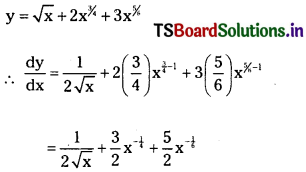
![]()
(ii) \(\sqrt{2 x-3}+\sqrt{7-3 x}\)
Answer:
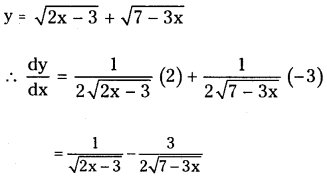
(iii) (x2 – 3) (4x3 + 1)
Answer:
y = (x2 – 3) (4x3 + 1)
\(\frac{\mathrm{dy}}{\mathrm{dx}}\) = (x2 – 3) \(\frac{\mathrm{d}}{\mathrm{dx}}\) (4x3 + 1) + (4x3 + 1) \(\frac{\mathrm{d}}{\mathrm{dx}}\) (x2 – 3)
= (x2 – 3) (12x2) + (4x3 + 1) (2x)
= 12x4 – 36x2 + 8x4 + 2x = 20x4 – 36x2 + 2x
(iv) (√x – 3x) (x + \(\frac{1}{x}\))
Answer:
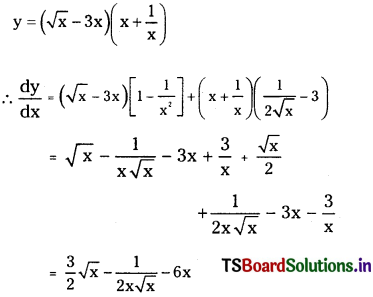
(v) (√x + 1) (x2 – 4x + 2) (x > 0)
Answer:
y = (√x + 1) (x2 – 4x + 2)
\(\frac{d y}{d x}\) = (√x + 1) \(\frac{d}{d x}\) (x2 – 4x + 2) + (x2 – 4x + 2) \(\frac{d}{d x}\) (√x + 1)
= (√x + 1) (2x – 4) + (x2 – 4x + 2) \(\left(\frac{1}{2 \sqrt{x}}\right)\)
= (√x + 1) (2x – 4) + \(\frac{x^2-4 x+2}{2 \sqrt{x}}\)
(vi) (ax + b)n (cx + d)m
Answer:
Let y = (ax + b)n (cx + d)m
\(\frac{d y}{d x}\) = (ax + b)n . m(cx + d)m – 1(c) + (cx + d)m n (ax + b)n – 1 (a)
= (ax + b)n (cm (cx + d)m – 1] + (cx + d)m [an(ax + b)n – 1]
= (ax + b)n – 1 (cx + d)m – 1 [cm (ax + b) + an(cx + d)]
= (ax + b)n (cx + d)m \(\left[\frac{a n}{a x+b}+\frac{c m}{c x+d}\right]\)
(vii) 5 sin x + ex log x
Answer:
y = 5 sin x + ex log x
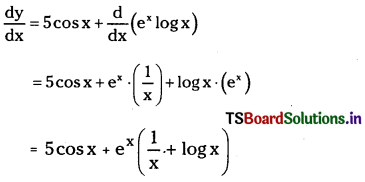
![]()
(viii) 5x + log x + x3 ex
Answer:
y = 5x + log x + x3 ex
∴ \(\frac{\mathrm{dy}}{\mathrm{dx}}\) = 5x log 5 + \(\frac{1}{x}\) + [x3ex + 3x2ex]
(ix) ex + sin x cos x
Answer:
y = ex + sin x cos x
\(\frac{\mathrm{dy}}{\mathrm{dx}}\) = ex + sin x (- sin x) + cos x (cos x) dx
= ex + cos2 x – sin2 x = ex + cos 2x
(x) \(\frac{p x^2+q x+r}{a x+b}\) (|a| + |b| ≠ 0)
Answer:
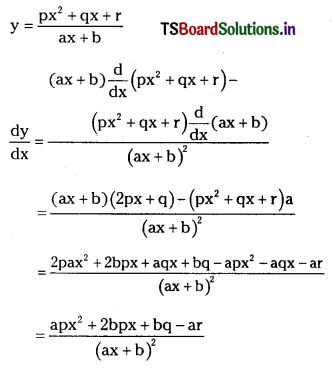
(xi) log7(log x) (x > 0)
Answer:
y = log7(log x)
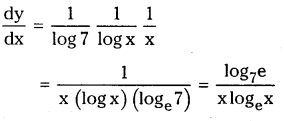
(xii) \(\frac{1}{a x^2+b x+c}\) (|a| + |b| + |c| ≠ 0)
Answer:
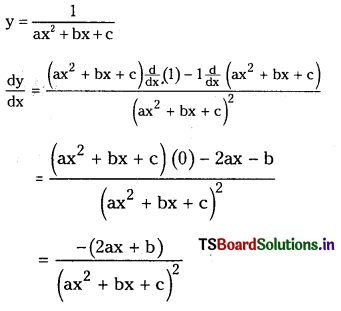
(xiii) e2x log (3x + 4) (x > – 4/3)
Answer:
y = e2x log (3x + 4) (x > – 4/3)
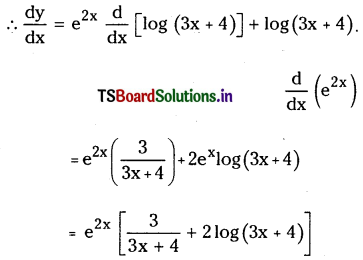
![]()
(xiv) (4 + x2) e2x
Answer:
y = (4 + x2) e2x
∴ \(\frac{\mathrm{dy}}{\mathrm{dx}}\) = (4 + x2) \(\frac{\mathrm{d}}{\mathrm{dx}}\) (e2x) + e2x . \(\frac{\mathrm{d}}{\mathrm{dx}}\) (4 + x2)
= (4 + x2) (2e2x) + e2x (2x)
= 2e2x (x2 + x + 4)
(xv) \(\frac{a x+b}{c x+d}\) (|c| + |d| ≠ 0) (May 2022)
Answer:
y = \(\frac{a x+b}{c x+d}\)
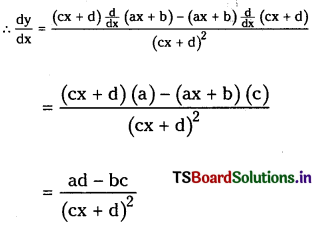
(xvi) ax.ex2 (Board New Model Paper)
Answer:
y = ax.ex2
Then
\(\frac{\mathrm{dy}}{\mathrm{dx}}\) = ax . \(\frac{\mathrm{d}}{\mathrm{dx}}\) (ex2) + \(\frac{\mathrm{d}}{\mathrm{dx}}\) (ax)
= ax (2x) ex2 + ex2 . ax logea
= ax ex2 (2x + logea)
= y (2x + logea)
Question 2.
If f(x) = (1 + x + x2 + …… + x100) then find f ‘(1). (V.S.A.Q.)
Answer:
f(x) = (1 + x + x2 + ……. + x100)
Then f(x) = 1 + 2x+ 3x2 + …………….. + 100x99
and f’(1) = 1 + 2 + 3 + ………………. + 100
= \(\frac{100(100+1)}{2}\) = 101 × 50 = 5050
(∵ Σn = \(\frac{\mathrm{n}(\mathrm{n}+1)}{2}\))
Question 3.
If f(x) = 2x + 3x – 5 then prove that f ‘(0) + 3f ‘( -1) = 0. (V.S.A.Q.)
Answer:
Given f(x) = 2x2 + 3x – 5
Then f'(x) = 4x + 3
∴ f(0) + 3f (- 1) = 3 + 3 [4 (- 1) + 3] = 3 – 3 = 0
![]()
II.
Question 1.
Find the derivatives of the following functions from the first principle. (S.A.Q.)
(i) x3
Answer:
Let f(x) = x3 then
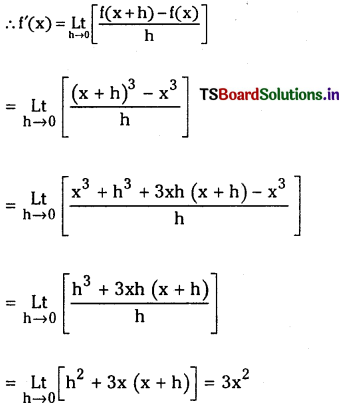
(ii) x4 + 4
Answer:
let f(x) = x4 + 4
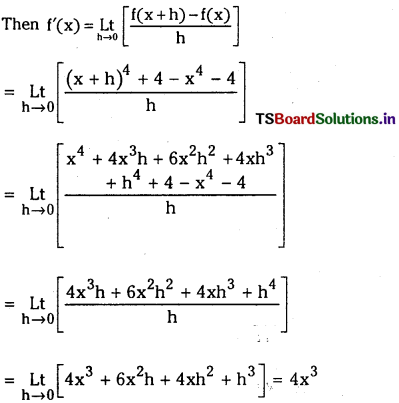
(iii) ax2 + bx + c
Answer:
Let f(x) = ax2 + bx + c
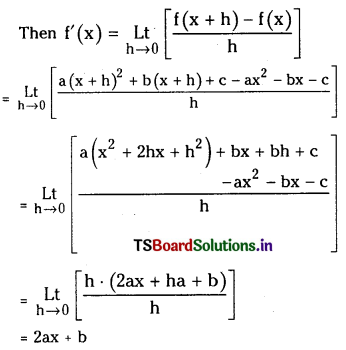
![]()
(iv) √x + 1
Answer:
Let f(x) = √x + 1
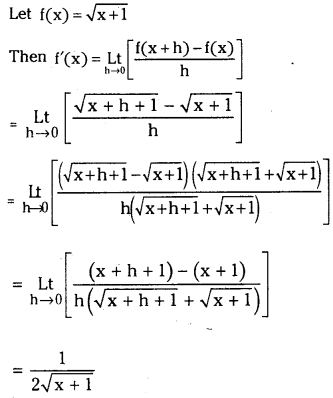
(v) sin 2x (Board New Model Paper)
Answer:
Let f(x) = sin 2x
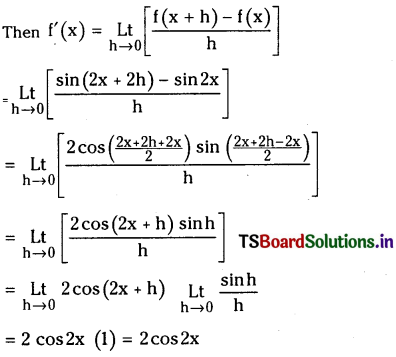
(vi) cos ax (May 2014, March 2013, 2011)
Answer:
Let f(x) = cos ax
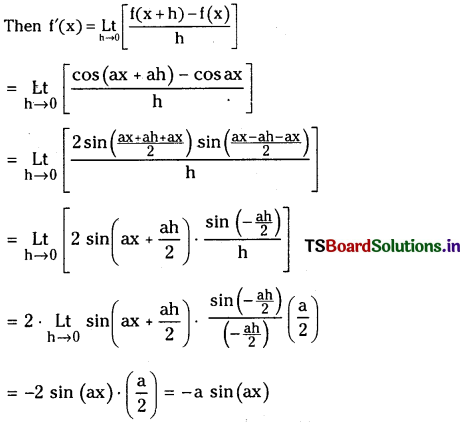
![]()
(vii) tan 2x (March 2014, May 2011)
Answer:
Let f(x) = tan 2x
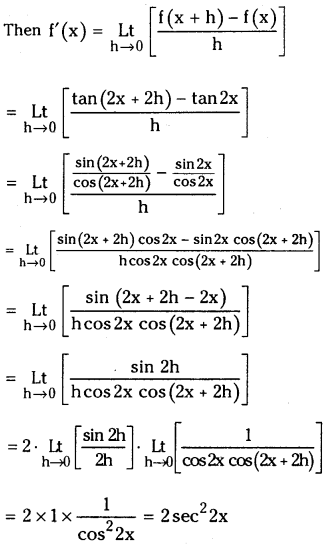
(viii) cot x
Answer:
let f(x) = cot x
then
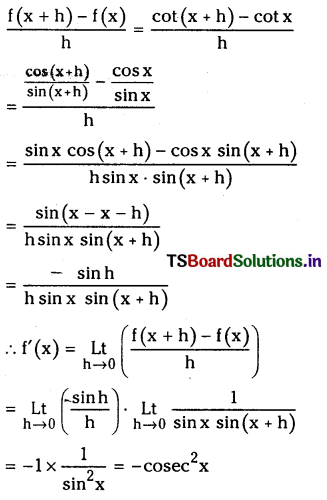
(ix) sec 3x
Answer:
Let f(x) = sec 3x
then
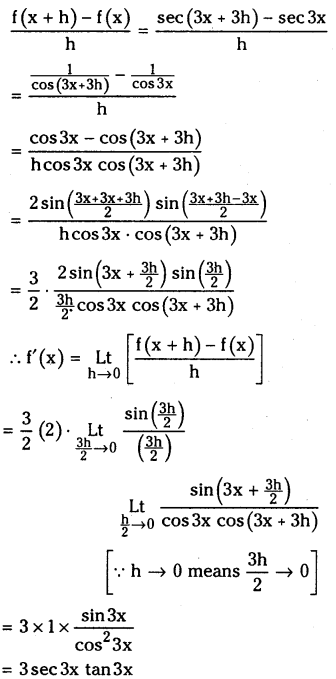
![]()
(x) x sin x
Answer:
Let f(x) = x sin x
Then f(x + h) – f(x) = (x + h) sin (x + h) – x sin x
= x [sin(x + h) – sin x] + h sin (x + h)
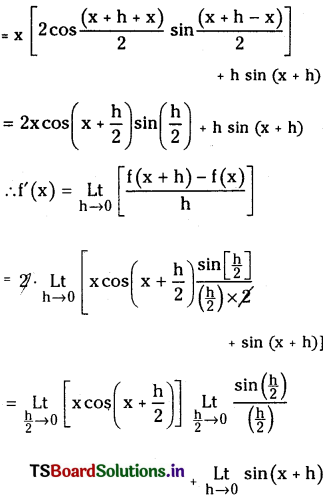
= x cos x × 1 + sin x
= x cos x + sin x
(xi) cos2x
Answer:
Let f(x) = cos2x
Then f (x + h) – f(x) = cos2 (x + h) – cos2x
= [1 – sin2(x + h)] – (1 – sin2x)
= sin2x – sin2(x + h)
= sin (x + x + h) sin (x – x – h)
= sin (2x + h) sin (- h)
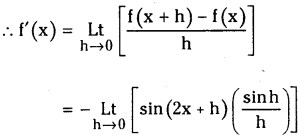
= – sin 2x × 1 = – sin 2x
Question 2.
Find the derivatives of the following functions. (S.A.Q.)
(i) \(\frac{1-x \sqrt{x}}{1+x \sqrt{x}}\) (x > 0)
Answer:
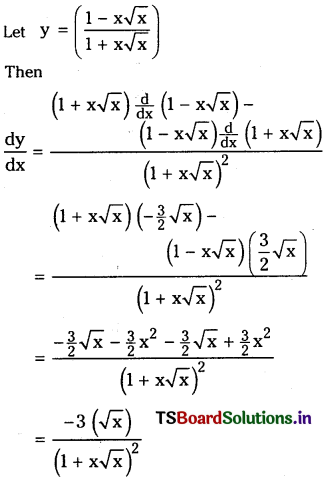
![]()
(ii) xn nx log (nx), (x > 0, n ∈ N)
Answer:
Let y = xn nx log (nx)
Then
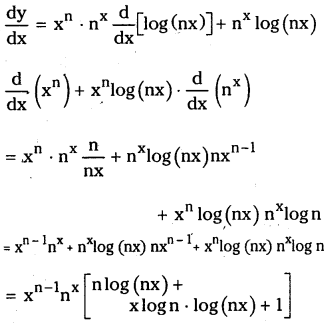
(iii) ax2n log x + bxn e-x
Answer:
Let y = ax2n log x + bxn e-x

= a [x2n – 1 + 2nx2n – 1 log x] + b [- xn e-x + ne-x xn – 1]
= ax2n – 1 + 2anx2n – 1 log x – bxne-x + bne-x xn – 1
(iv) \(\left(\frac{1}{x}-x\right)^3\) ex
Answer:
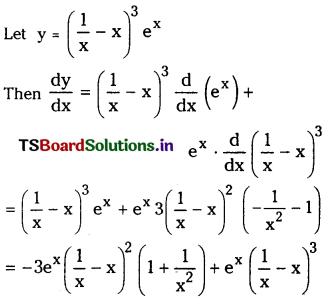
Question 3.
Show that the function f(x) = | x | + | x – 1| x ∈ R is differentiable for all real numbers except for 0 and 1. (S.A.Q.)
Answer:
f(x) = |x| + |x – 1| ∀ x ∈ R
then f(x) = x + x – 1 = 2x – 1, x ≥ 1
= x – (x – 1) = x – x + 1 = 1, 0 < x < 1
= – x – (x – 1)
= – x – x + 1 = 1 – 2x; x ≤ 0
∴ f(x) = 2x – 1, x ≥ 1
= 1, 0 < x < 1 = 1 – 2x; x ≤ 0 If x > 1, then f(x) = 2x – 1 which is a polynomial differentiable for all x > 1.
If 0 < x ≤ 1, then f(x) = 1 = Constant which is differentiable.
Case (i): Differentiability at x = 0:
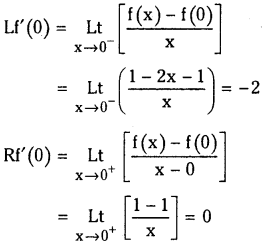
∵ Lf'(0) ≠ Rf'(0), the function f is not differentiable at x = 0.
Case (i): Differentiability at x = 1:
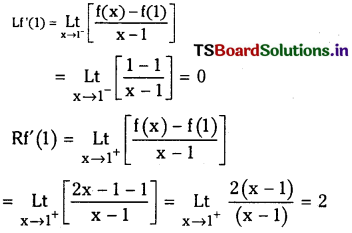
∵ Lf'(1) ≠ Rf'(1) we say that f(x) is not differentiable at x = 1.
∴ f(x) is differentiable for all real x except zero and one.
![]()
Question 4.
Verify whether the following function is differentiable at 1 and 3. (S.A.Q.)

Answer:
Case (i):
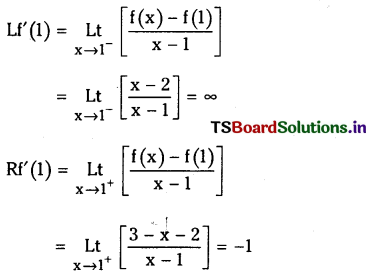
Case (ii):
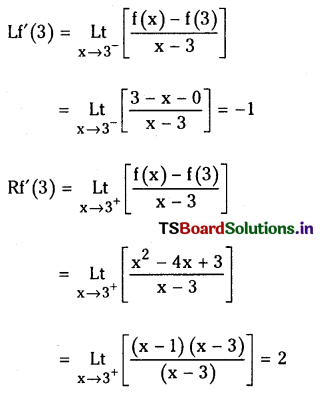
Since Lf'(3) ≠ Rf'(3), f(x) is not differentiable at x = 3.
Question 5.
Is the following function f differentiable at 2 ? Justify. (S.A.Q.)

Answer:
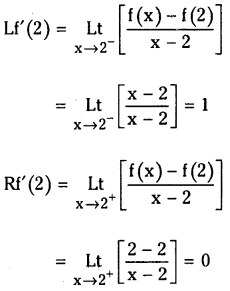
Since Lf'(2) ≠ Rf'(2), we say f(x) is not differentiable at x = 2.